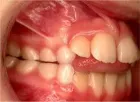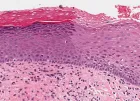Abstract
Review Article
Open bite malocclusion: An overview
Rohit Kulshrestha*, Mohamed Abdul Wajid, Pratik Chandra, Kamlesh Singh, Ramji Rastogi and Vinay Umale
Published: 12 January, 2018 | Volume 3 - Issue 1 | Pages: 011-020
The term open bite is referred as no contact between anterior or posterior teeth. The complexity of open bite is attributed to a combination of skeletal, dental and habitual factors. Etiology of open bite can be attributed to genetics, anatomic and environmental factors. However, the tendency toward relapse after conventional or surgical orthodontic treatment has been indicated. Therefore, open bite is considered one of the most challenging dentofacial deformities to treat. The aim of this article is to emphasize that early etiological diagnosis, dentofacial morphology and classification are essential to the successful outcome of the technical intervention. Failure of tongue posture adaptation subsequent to orthodontic and/or surgical treatment might be the primary reason for relapse of open bite. Prolonged retention with fixed or removable retainers is advisable and necessary in most cases of open bite treatment. The treatment of open bite remains a tough challenge to the clinician; careful diagnosis and timely intervention with proper treatment modalities and appliance selection will improve the treatment outcomes and long-term stability.
Read Full Article HTML DOI: 10.29328/journal.johcs.1001022 Cite this Article Read Full Article PDF
Keywords:
Open bite; Malocclusion; Aetiology
References
- Alderico Artese, Stephanie Drummond, Juliana Mendes do Nascimento, Flavia Artese. Criteria for diagnosing and treating anterior open bite with stability. Dental Press J Orthod. 2011; 16:136-161. Ref.: https://goo.gl/NhJcLs
- Pithon MM. Angle Class I malocclusion with anterior open bite treated with extraction of permanent teeth. Dental Press J Orthod. 2013; 18:133-140. Ref.: https://goo.gl/Qe5xDy
- Cabrera Mde C, Cabrera CA, de Freitas KM, Janson G, de Freitas MR. Lateral open bite: Treatment and stability. Am J Orthod Dentofacial Orthop. 2010; 137: 701-711. Ref.: https://goo.gl/YSzD9i
- Shapiro PA. Stability of open bite treatment. Am J Orthod Dentofacial Orthop. 2002; 121: 566-568. Ref.: https://goo.gl/6cjZLc
- Cozza P, Mucedero M, Baccetti T, Franchi L. Early orthodontic treatment of skeletal open bite malocclusion: a systematic review. Angle Orthod. 2005; 75: 707-713. Ref.: https://goo.gl/goYmYb
- Subtelny JD, Sakuda M. Open Bite: diagnosis and treatment. Am J Orthod 1964; 50: 337-358. Ref.: https://goo.gl/djgwjt
- Moyers RE. Ortodontia. 4 ed. Trad. coord. Por Aloysio Cariello. Rio de Janeiro:Guanabara Koogan. 1991.
- Teittinen M, Tuovinen V, Tammela L, Schatzle M, Peltomaki T. Long-term stability of anterior open bite closure corrected by surgical-orthodontic treatment. Eur J Orthod. 2012; 34: 238-243. Ref.: https://goo.gl/rKKXMf
- Farret MMB, Tomé MC, Jurach EM, Pires RTT. Efeitos na mordida aberta anterior a partir do reposicionamento postural da língua. Ortodon Gaúcha. 1999; 3: 119-124.
- Kim YH, Han UK, Lim DD, Serraon ML. Stability of anterior openbite correction with multiloop edgewise archwire therapy: a cephalometric follow up study. Am J Orthod Dentofacial Orthop. 2000; 118: 43-54. Ref.: https://goo.gl/nFJktq
- Sodré AS, Franco EA, Monteiro DF. Mordida aberta anterior. J Bras Ortodon Ortop Facial. 1998; 3: 80-94.
- Pedrazzi E. Treating the open bite. J Gen Orthod. 1997; 8: 5-16. Ref.: https://goo.gl/qKaCZh
- Meyer-Marcotty P, Hartmann J, Stellzig-Eisenhauer A. Dentoalveolar open bite treatment with spur appliances. J Orofac Orthop. 2007; 68: 510-521. Ref.: https://goo.gl/ZTuyFr
- Rodriguez Esequiel, Casasa Rogelio. Ortodoncia Contemporanea. Diagnostico y Tratamiento. Editorial Actualidades Medico Odontologicas Latinoamerica C.A. Primera edicion. 2005.
- Chang Young, Cheol Moon Seong. Cephalometric evaluation of the anterior open bite treatment. AJO. 1999.
- Greenlee GM, Huang GJ, Chen SS, Chen J, Koepsell T, et.al. Stability of treatment for anterior open-bite malocclusion: a meta-analysis. Am J Orthod Dentofacial Orthop. 2011; 139: 154-169. Ref.: https://goo.gl/XuUaA1
- Ricketts, Robert. Tecnica bioprogresiva de Ricketts. Editorial Medica Panamerican. SA Pag. 95: 97. 30.
- Saadia Marc, Ahlin Jeffrey H. Atlas de Ortopedia dentofacial durante el crecimiento. Editorial Espaxs. SAP. 67: 80-81.
- Lawry DM, Heggie AA, Crawford EC, Ruljancich MK. A review of the management of anterior open bite malocclusion. 1990; 11: 147-160. Ref.: https://goo.gl/5bZY8B
- Justus R. Correction of anterior open bite with spurs: long term stability. World J Orthod. 2001; 2: 219-231. Ref.: https://goo.gl/n9LsPf
- Proffit WR. Contemporary orthodontics. The C.V. Mosby Company. 1986.
- Weinmann JP, schier H. Bone and bones fundamentals of bone biology. St. Louis. The C.V. Mosby Company. 1947.
- Scott JH. Dentofacial Development and growth Oxford. Pergamon Press. 1967.
- Moss M.L. The functional matrix in Kraus BS, Riedel RA. (Editors) Vistas in Orthodontics Philadelphia. Lea and Febiger. 1962.
- Subtelny DJ, Sukuda, M. open bite diagnosis and treatment. Am J Orthod. 1964; 50: 337-358.
- Tulley WJ. A critical appraisal of tongue thrusting. Am J Orthod. 1969; 55: 640-650. Ref.: https://goo.gl/KfXLhx
- Gershater MM. The proper perspective of open bite. Angle Orthod.1970; 42: 263-272. Ref.: https://goo.gl/A8GvH7
- Popovich F, Thompson GW. Thumb and finger sucking: It’s Relationship to malocclusion. Am J Orthod. 1973; 63: 148-155. Ref.: https://goo.gl/LF1wGU
- Neff CW, Kydd WL. The open bite physiology and occlusion. Angle Orthod. 1966; 36: 351-357. Ref.: https://goo.gl/kMoHZ9
- Proffitt WR, Mason RM. Myo- functional theory for tongue thrusting: Background and recommendations. American Dental Association, 1975; 90: 403-411. Ref.: https://goo.gl/1PeDBN
- Zuroff JP, Chen SH, Shapiro PA, Little RM, Joondeph DR, et.al. Orthodontic treatment of anterior open-bite malocclusion: stability 10 years post retention. Am J Orthod Dentofacial Orthop. 2010; 137: 302 -302.
- Speidel TM, Isaacson RJ, Worms FM. Tongue thrust therapy and Anterior dental open bite. Am J Orthod. 1972; 62: 287-295. Ref.: https://goo.gl/Z4tSGU
- Schudy FF. Vertial growth versus anterior posterior growth as releted to function and treatment. Angle. Orthod. 1964; 34: 75-93.
- Enlow DH. Postnatal facial growth: in forrester. DJ Wagner, M.L fleming, F (edn): Pediatric dental madicinephiladelphia: Lea and Febiges, 1981; 40-54.
- Graber TM. Orthodontic principle and practice. 3rd edition Philadelphia. WB Saunder Company. 1972.
- Gianelly AA. Craniofacial Growth and development: in Braham Rl, Morris, ME (eds) op. cit. 1980; 25-45.
- Goose DH, Appleton J. Human Dentofacial Growth oxford. Permagon Press. 1982.
- Coben SE. Growth and Cl. II treatment. Am J orthod. 1966; 52: 5-26.
- Enlow DH, Bang S. Growth and Remodelling of the Human Maxilla. Am J Orthod. 1965; 51: 446-464.
- Worms FW, Meskin LH, Isaacson RJ. Open bite. American Journal of Orthodontics. 1971; 59: 589-595. Ref.: https://goo.gl/zY1Dsa
- Cozza P, Mucedero M, Baccetti T, Franchi L. Early orthodontic treatment of skeletal open bite malocclusion: a systematic review. Angle Orthod. 2005; 75: 707-713. Ref.: https://goo.gl/UcEaQR
- Shapiro PA. Stability of open bite treatment. Am J Orthod Dentofacial Orthop. 2002; 121: 566-568. Ref.: https://goo.gl/co7EJ1
- Bilodeau JE. Nonsurgical treatment of a Class III patient with a lateral open-bite malocclusion. Am J Orthod Dentofacial Orthop. 2011; 140: 861-868. Ref.: https://goo.gl/bvTjmi
- Park YC, Lee HA, Choi NC, Kim DH. Open Bite Correction by Intrusion of Posterior Teeth with mini-screws. Angle Orthodontist. 2008; 78: 699-710. Ref.: https://goo.gl/ULQ5B1
- Togawa R, Lino S, Miyawaki S. Skeletal Class III and open bite treated with bilateral sagittal split osteotomy and molar intrusion using titanium screws. AngleOrthod. 2010; 80: 1176–1184. Ref.: https://goo.gl/sX8TPU
- Proffit WR, Bailey LJ, Phillips C, Turvey TA. Long-Term Stability of Surgical Open-Bite Correction by Le Fort I Osteotomy. Angle Orthod. 2000; 70: 112–117. Ref.: https://goo.gl/snEfCw
- Nielson I.L. Vertical malocclusions, etiology, development, diagnosis and some aspects of treatment. Angle orthodontist. 1991; 61: 247-257. Ref.: https://goo.gl/dsZDqn
- Torres FC, Almeida RR, Almeida-Pedrin RR, Pedrin F, Paranhos LR. Dentoalveolar comparative study between removable and fixed cribs, associated to chin cup, in anterior open bite treatment. J Appl Oral Sci. 2012; 20: 531-537.
- Cangialosi TJ. Skeletal morphologic features of anterior open bite. American Journal of Orthodontics. 1984; 85: 29-36. Ref.: https://goo.gl/daGTHi
Figures:

Figure 1

Figure 2

Figure 3

Figure 4
Similar Articles
-
Evaluation of Horizontal Lip Position in Adults with Different Skeletal Patterns: A Cephalometric StudyRohit Kulshrestha*,Vinay V Umale,Kamlesh Singh,Aftab Azam,Madhvi Bhardwaj. Evaluation of Horizontal Lip Position in Adults with Different Skeletal Patterns: A Cephalometric Study . . 2017 doi: 10.29328/journal.johcs.1001005; 2: 009-016
-
Corticotomy facilitated correction of skeletal class II malocclusionArif Yezdani A*. Corticotomy facilitated correction of skeletal class II malocclusion. . 2017 doi: 10.29328/journal.johcs.1001018; 2: 096-103
-
Fixed functional Appliances in Orthodontics-A reviewDevinder Preet Singh*,Ramanpreet Kaur . Fixed functional Appliances in Orthodontics-A review. . 2018 doi: 10.29328/journal.johcs.1001021; 3: 001-010
-
Open bite malocclusion: An overviewRohit Kulshrestha*,Mohamed Abdul Wajid,Pratik Chandra,Kamlesh Singh,Ramji Rastogi,Vinay Umale. Open bite malocclusion: An overview. . 2018 doi: 10.29328/journal.johcs.1001022; 3: 011-020
Recently Viewed
-
CT-guided Retrograde Urography as a Diagnostic Tool for Post-kidney Transplantation Evaluation: A Case ReportHan-Mei Chang, Chan-I Su, Ching-Ting Chang*. CT-guided Retrograde Urography as a Diagnostic Tool for Post-kidney Transplantation Evaluation: A Case Report. J Clin Med Exp Images. 2023: doi: 10.29328/journal.jcmei.1001028; 7: 004-006
-
Dual Role of Clinician Managers in Healthcare - Challenges and OpportunitiesAhsana Nazish*. Dual Role of Clinician Managers in Healthcare - Challenges and Opportunities. J Clin Med Exp Images. 2023: doi: 10.29328/journal.jcmei.1001029; 7: 007-013
-
Pancreatico-gastric FistulaRony Varghese*, Amal Upadhyay, Pawan Kumar Jaiprakah Maniyar. Pancreatico-gastric Fistula. J Clin Med Exp Images. 2024: doi: 10.29328/journal.jcmei.1001030; 8: 001-002
-
A Rare Consanguineous Case of Alazami Syndrome in a Jordanian Family: Clinical Presentation, Genetic Analysis, and Therapeutic Approaches - A Case ReportFawzi Irshaid*, Salim Alawneh, Qasim Al Souhail, Aisha Alshdefat, Bashar Irshaid, Ahmed Irshaid. A Rare Consanguineous Case of Alazami Syndrome in a Jordanian Family: Clinical Presentation, Genetic Analysis, and Therapeutic Approaches - A Case Report. J Clin Med Exp Images. 2024: doi: 10.29328/journal.jcmei.1001031; 8: 003-006
-
Establishment of a Best Practice Recommendation (BPR) for Abdominal Aortic Aneurysms in a Large Multi-State Radiology Practice: Adoption and ImpactAndrew K Hillman, Phil Ramis, Patrick Nielsen, Eric M Rohren*. Establishment of a Best Practice Recommendation (BPR) for Abdominal Aortic Aneurysms in a Large Multi-State Radiology Practice: Adoption and Impact. J Clin Med Exp Images. 2024: doi: 10.29328/journal.jcmei.1001032; 8: 007-012
Most Viewed
-
Causal Link between Human Blood Metabolites and Asthma: An Investigation Using Mendelian RandomizationYong-Qing Zhu, Xiao-Yan Meng, Jing-Hua Yang*. Causal Link between Human Blood Metabolites and Asthma: An Investigation Using Mendelian Randomization. Arch Asthma Allergy Immunol. 2023 doi: 10.29328/journal.aaai.1001032; 7: 012-022
-
Impact of Latex Sensitization on Asthma and Rhinitis Progression: A Study at Abidjan-Cocody University Hospital - Côte d’Ivoire (Progression of Asthma and Rhinitis related to Latex Sensitization)Dasse Sery Romuald*, KL Siransy, N Koffi, RO Yeboah, EK Nguessan, HA Adou, VP Goran-Kouacou, AU Assi, JY Seri, S Moussa, D Oura, CL Memel, H Koya, E Atoukoula. Impact of Latex Sensitization on Asthma and Rhinitis Progression: A Study at Abidjan-Cocody University Hospital - Côte d’Ivoire (Progression of Asthma and Rhinitis related to Latex Sensitization). Arch Asthma Allergy Immunol. 2024 doi: 10.29328/journal.aaai.1001035; 8: 007-012
-
An algorithm to safely manage oral food challenge in an office-based setting for children with multiple food allergiesNathalie Cottel,Aïcha Dieme,Véronique Orcel,Yannick Chantran,Mélisande Bourgoin-Heck,Jocelyne Just. An algorithm to safely manage oral food challenge in an office-based setting for children with multiple food allergies. Arch Asthma Allergy Immunol. 2021 doi: 10.29328/journal.aaai.1001027; 5: 030-037
-
Snow white: an allergic girl?Oreste Vittore Brenna*. Snow white: an allergic girl?. Arch Asthma Allergy Immunol. 2022 doi: 10.29328/journal.aaai.1001029; 6: 001-002
-
Cytokine intoxication as a model of cell apoptosis and predict of schizophrenia - like affective disordersElena Viktorovna Drozdova*. Cytokine intoxication as a model of cell apoptosis and predict of schizophrenia - like affective disorders. Arch Asthma Allergy Immunol. 2021 doi: 10.29328/journal.aaai.1001028; 5: 038-040

If you are already a member of our network and need to keep track of any developments regarding a question you have already submitted, click "take me to my Query."


















































































































































